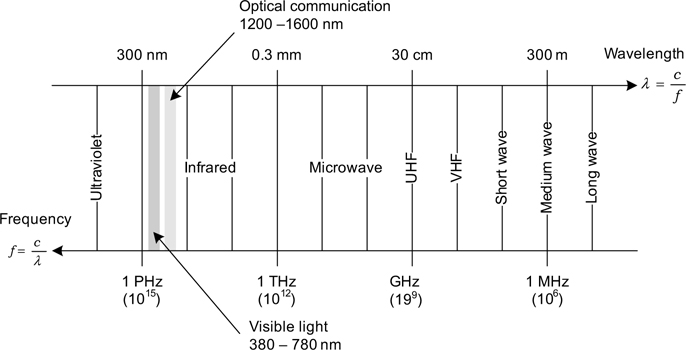3
OPTICAL LAYER
In this chapter:
- Light propagation phenomena
- Optical components in PONs
- Fiber
- Splices and connectors
- Passive power splitters
- WDM devices
- Optical budgets
- Coexistence of G-PON and XG-PON
- Transceivers
- Lasers and drivers
- Photodetectors, optical amplifiers
- Receiver sensitivity, threshold determination, clock recovery
- Reach extension
- SOAs, EDFAs
- Optical-electrical-optical repeaters
- Optical amplifier-based repeaters

Figure 3.1 Electromagnetic spectrum.
3.1 INTRODUCTION
Before we look into the passive and active components that comprise the physical layer of a PON, we briefly review the fundamental behavior of light: the speed of light in different materials, reflection, refraction, and polarization.
Figure 3.1illustrates the electromagnetic spectrum, in particular, the range of interest for G-PON and XG-PON systems.
3.1.1 Light Propagation
When the wavelength of light is much smaller than the dimensions of the surrounding geometry, light propagates in straight lines (rays) as it travels through free space or transparent materials. Large-scale effects such as reflection and refraction are easily described in terms of rays.
The speed of light in free space (vacuum), designated as c, is very close to 300,000 km/s (in fact, 299,792,458 m/s) and is a physical constant. The free-space wavelength λ of a wave of frequency f is the distance traveled by the wave during ...
Get Gigabit-capable Passive Optical Networks now with the O’Reilly learning platform.
O’Reilly members experience books, live events, courses curated by job role, and more from O’Reilly and nearly 200 top publishers.

